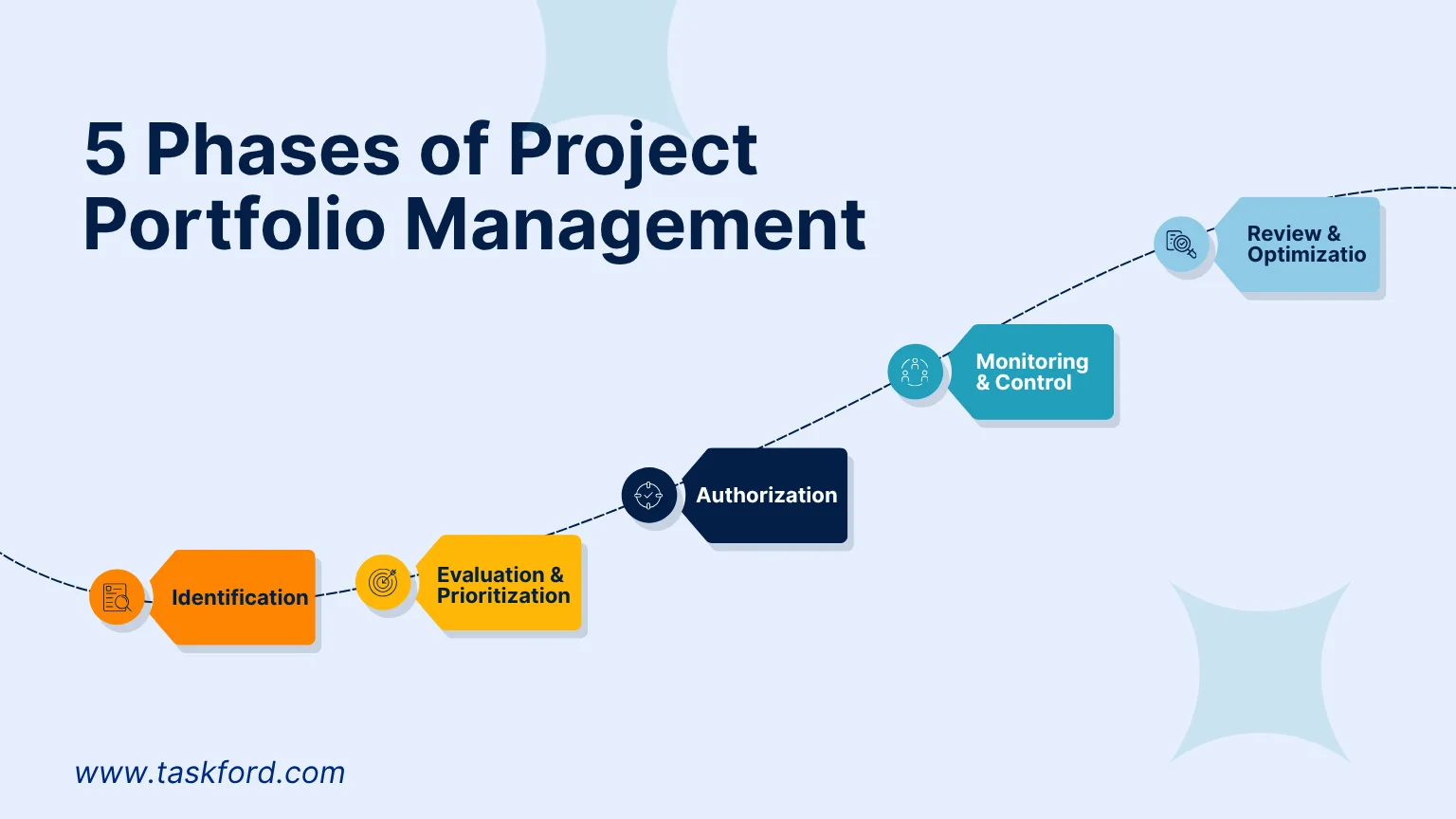Project Portfolio Management: The Backbone of a Value-Driven PMO
Discover how project portfolio management drives a value-driven PMO. Learn strategies to align projects, optimize resources, and deliver measurable results.
Project Portfolio Management (PPM) sits at the center of how modern organizations turn strategy into measurable outcomes. For a Project Management Office (PMO), it is more than a framework for tracking projects; it is the structure that ensures every initiative contributes tangible value to business goals.
A value-driven PMO relies on PPM to connect strategic intent with execution. By managing resources, priorities, and risks across the entire portfolio, leaders gain the clarity needed to make informed decisions and allocate effort where it creates the greatest impact. When implemented effectively, project portfolio management transforms the PMO from a reporting function into a strategic partner that enables sustainable growth and organizational agility.
This article explores how project portfolio management forms the backbone of a value-driven PMO, outlining its key pillars and five main phases to deliver consistent results.
What is Project Portfolio Management?
Project Portfolio Management (PPM) is a structured approach to selecting, prioritizing, and managing an organization’s projects to achieve its strategic objectives. It provides a centralized framework for evaluating which initiatives deliver the greatest value, ensuring that time, budget, and talent are directed toward the most impactful work.
Unlike project management, which focuses on delivering individual projects successfully, PPM looks across the entire landscape of projects and programs. It gives leadership a unified view of performance, risk, and resource utilization, helping them balance short-term operational needs with long-term strategic goals.
An effective PPM practice aligns every project with measurable business outcomes. It bridges the gap between strategy formulation and execution by providing decision-makers with the data and visibility needed to adapt priorities as conditions evolve. For the PMO, this discipline becomes the foundation for consistency, accountability, and continuous improvement, transforming scattered project activity into an integrated portfolio that drives organizational value.
Project Management vs. Program Management vs. Portfolio Management

Understanding the distinction between project, program, and portfolio management is essential for defining how each contributes to organizational performance. Although these disciplines share a common goal, successful delivery, they operate at different levels of scope and strategy.
- Project Management focuses on execution. It ensures that a specific initiative meets its defined objectives within scope, time, and budget. Project managers oversee deliverables, schedules, and risks at the individual project level, emphasizing operational control and quality outcomes.
- Program management takes a broader view. A program consists of multiple related projects managed together to achieve benefits that would not be realized if managed separately. The program manager coordinates dependencies, resolves conflicts, and aligns projects toward a shared business objective or capability.
- Portfolio Management, on the other hand, operates at the strategic level. It involves selecting and prioritizing projects and programs to ensure alignment with the organization’s overarching goals. The focus is on value optimization, resource balance, and strategic fit, rather than the direct delivery of outputs. Portfolio managers evaluate investments, assess risks, and determine which initiatives should continue, pause, or stop based on performance and business priorities.
In essence, projects deliver outputs, programs deliver outcomes, and portfolios deliver strategic value. Together, they create a hierarchy of alignment that enables the PMO to connect day-to-day execution with enterprise strategy, ensuring that every effort contributes to meaningful business results.
Why Project Portfolio Management Is the PMO’s Strategic Backbone
For a Project Management Office (PMO), Project Portfolio Management (PPM) provides the structure that connects strategic direction with execution. It transforms the PMO from a support function into a central driver of business performance by ensuring that every project, program, and investment aligns with organizational goals.
Through PPM, the PMO gains enterprise-wide visibility—a consolidated view of all active and proposed initiatives. This transparency enables leadership to make informed decisions about where to invest resources, when to adjust priorities, and how to balance short-term delivery with long-term strategy. Without portfolio management, projects often compete for funding and talent, leading to inefficiency, duplication, and misalignment with business objectives.
PPM also strengthens the PMO’s ability to measure value. By linking projects to strategic outcomes, the PMO can demonstrate tangible impact, such as improved ROI, faster time-to-market, or increased customer satisfaction. It shifts the focus from tracking activities to tracking benefits, creating a culture where performance is defined by contribution to organizational success rather than project completion alone.
In essence, Project Portfolio Management is the PMO’s strategic backbone because it provides three core capabilities: alignment, control, and insight. Alignment ensures that every project supports the enterprise vision. Control delivers governance and accountability across the portfolio. Insight enables leaders to make proactive, data-driven decisions that sustain long-term value. Together, these elements position the PMO as a strategic partner, not just an administrative entity.
Key Pillars of a Value-Driven PMO Supported by PPM

A value-driven PMO relies on Project Portfolio Management (PPM) to transform strategy into measurable outcomes. Rather than focusing solely on oversight or compliance, it emphasizes delivering tangible business value, measured through alignment, efficiency, transparency, and impact.
Below are four key pillars that define how PPM enables a PMO to create and sustain that value.
1. Strategic Alignment
A successful PMO ensures that every project supports the organization’s broader strategic objectives. Through PPM, leaders can align portfolios with organizational OKRs (Objectives and Key Results), strategic themes, or key business priorities.
Portfolio management provides the data and structure needed to evaluate whether projects contribute directly to those goals. Frameworks such as the Balanced Scorecard or value mapping help translate strategic intent into actionable investments. This alignment ensures resources are directed toward initiatives that advance enterprise success, not just operational efficiency.
2. Resource Optimization
Optimizing resources is central to maintaining a balanced and productive portfolio. PPM gives visibility into capacity, skill distribution, and workload across teams, allowing the PMO to allocate talent where it adds the most value.
By using portfolio analytics and forecasting tools, leaders can anticipate bottlenecks, identify underutilized expertise, and make proactive adjustments. This balance leads to higher project throughput, improved morale, and greater organizational agility. In a value-driven PMO, resources are not just managed; they are strategically invested.
3. Governance and Transparency
Effective governance ensures that projects are executed within a clear, consistent framework. PPM strengthens governance by establishing standardized processes, metrics, and reporting structures across the portfolio.
Real-time dashboards and performance indicators allow executives to track progress, risks, and financials at a glance. Transparency builds trust between delivery teams and leadership, creating a culture of accountability. Instead of reacting to issues after the fact, the PMO can use portfolio insights to anticipate challenges and guide corrective action before they impact outcomes.
4. Value Measurement
In a value-driven PMO, success is defined by business outcomes, not just project completion. PPM enables this by linking project performance to measurable results such as ROI, cost savings, innovation impact, and customer satisfaction.
Beyond traditional metrics like time and budget, portfolio management helps quantify the strategic contribution of each initiative. Common indicators include Portfolio ROI, Strategic Goal Contribution Percentage, and Resource Utilization Efficiency. Measuring these factors allows the PMO to demonstrate clear, quantifiable value to stakeholders and continuously refine its investment strategy.
Together, these four pillars—strategic alignment, resource optimization, governance, and value measurement—form the foundation of a PMO that drives growth and resilience. Supported by effective PPM, they enable organizations to execute strategy with clarity, agility, and measurable success.
5 Phases of Project Portfolio Management

A mature Project Portfolio Management (PPM) process follows a clear lifecycle that enables organizations to evaluate, select, and manage initiatives strategically. These five phases provide a structured path for transforming strategic ideas into measurable business results while maintaining balance across scope, risk, and value.
1. Identification
The first phase involves identifying all potential projects and programs that could support organizational objectives. This step focuses on collecting ideas, proposals, and business cases from across the organization.
Each initiative is documented with essential information such as purpose, expected benefits, cost estimates, and resource requirements. The goal is to create a comprehensive inventory of opportunities that can later be assessed for strategic alignment and feasibility.
2. Evaluation and Prioritization
Once potential initiatives are identified, they must be evaluated based on predefined criteria such as strategic alignment, risk, financial return, and resource demand.
During this phase, the PMO uses scoring models or value matrices to compare projects objectively. Prioritization ensures that limited resources are invested in initiatives that offer the highest value and greatest contribution to strategic goals.
By applying consistent evaluation methods, organizations avoid subjective decision-making and maintain transparency in how investments are chosen.
3. Authorization
In the authorization phase, leadership approves the selected projects for inclusion in the active portfolio. This stage often involves budget allocation, resource planning, and scheduling.
Portfolio governance committees review recommendations, validate assumptions, and confirm that chosen initiatives align with overall business priorities. Once approved, projects officially move into execution under the oversight of the PMO.
4. Monitoring and Control
During execution, PPM provides real-time visibility into portfolio performance. The PMO tracks progress against key indicators such as budget utilization, resource capacity, schedule adherence, and strategic impact.
Dashboards, reports, and analytics tools allow leaders to make data-driven adjustments, reallocating resources, rebalancing priorities, or pausing low-value initiatives when necessary. This phase ensures that portfolio performance remains aligned with evolving organizational objectives.
5. Review and Optimization
The final phase focuses on evaluating outcomes and learning from results. The PMO conducts post-implementation reviews to assess whether projects delivered expected value and strategic benefits.
Insights from these reviews feed back into the next portfolio cycle, strengthening governance and decision-making. Continuous optimization turns PPM into an adaptive capability, one that evolves with the organization’s goals, market conditions, and innovation agenda.
Conclusion
A value-driven PMO thrives when strategy, execution, and measurement work in unison—and Project Portfolio Management is the framework that makes that possible. By integrating visibility, governance, and performance insight across all initiatives, PPM enables leaders to make informed choices about where to invest time, budget, and talent for the greatest organizational impact.
When implemented with structure and purpose, PPM transforms the PMO from a reporting function into a strategic enabler of growth. It provides the clarity to align projects with enterprise goals, the control to manage resources efficiently, and the insight to demonstrate measurable value.
As organizations navigate constant change and increasing complexity, the ability to manage portfolios dynamically becomes a defining advantage. For PMOs seeking to deliver consistent value, strengthen leadership confidence, and align every initiative with strategic intent, Project Portfolio Management truly is the backbone of sustainable success.
Making work simpler,
smarter, and more connected
Join our waitlist and be notified first.

Related Blog
Subscribe for Expert Tips
Unlock expert insights and stay ahead with TaskFord. Sign up now to receive valuable tips, strategies, and updates directly in your inbox.






